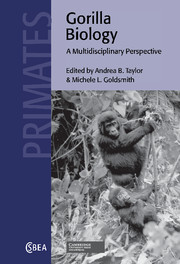Book contents
- Frontmatter
- Contents
- List of contributors
- Acknowledgments
- Epigraph
- Introduction: Gorilla biology: Multiple perspectives on variation within a genus
- Part 1 Gorilla taxonomy and comparative morphology
- 1 An introductory perspective: Gorillas – How important, how many, how long?
- 2 A history of gorilla taxonomy
- 3 Patterns of diversity in gorilla cranial morphology
- 4 The hierarchy of intraspecific craniometric variation in gorillas: A population-thinking approach with implications for fossil species recognition studies
- 5 Morphological differentiation of Gorilla subspecies
- 6 Ontogeny and function of the masticatory complex in Gorilla: Functional, evolutionary, and taxonomic implications
- 7 Intraspecific and ontogenetic variation in the forelimb morphology of Gorilla
- Part 2 Molecular genetics
- Part 3 Behavioral ecology
- Part 4 Gorilla conservation
- Afterword
- Index
- References
1 - An introductory perspective: Gorillas – How important, how many, how long?
Published online by Cambridge University Press: 11 August 2009
- Frontmatter
- Contents
- List of contributors
- Acknowledgments
- Epigraph
- Introduction: Gorilla biology: Multiple perspectives on variation within a genus
- Part 1 Gorilla taxonomy and comparative morphology
- 1 An introductory perspective: Gorillas – How important, how many, how long?
- 2 A history of gorilla taxonomy
- 3 Patterns of diversity in gorilla cranial morphology
- 4 The hierarchy of intraspecific craniometric variation in gorillas: A population-thinking approach with implications for fossil species recognition studies
- 5 Morphological differentiation of Gorilla subspecies
- 6 Ontogeny and function of the masticatory complex in Gorilla: Functional, evolutionary, and taxonomic implications
- 7 Intraspecific and ontogenetic variation in the forelimb morphology of Gorilla
- Part 2 Molecular genetics
- Part 3 Behavioral ecology
- Part 4 Gorilla conservation
- Afterword
- Index
- References
Summary
Gorillas rank highly among elephants, pandas, whales, polar bears, lions, orangutans, and other large mammals as awe-inspiring representatives of natura naturans (nature as creative) and natura naturata (nature as created). Like unique, imaginative, stimulating literature (Booth, 1988), one cannot encounter them without being changed in ways that are not easily explained. Indeed, attempts to do so can dilute the wonderful effect of having been in their presence. Earth will be a poorer planet if we lose its remaining, already impoverished, continental megafaunae and multifarious smaller beings and their natural habitats. The urgent pedagogical task of ecologists, educators, conservationists, policy-makers, and politicos is to generate appreciation for gorillas and a sense of local and national pride in having gorillas among indigenous peoples upon whom the stewardship of natural diversity is ultimately dependant (Tuttle, 1998).
Gorilla taxonomy is important for meaningful communication and reference, but questions over how many species or subspecies Gorilla comprises should be secondary to full descriptions of the morphological, genetic, social, demographic, and ecological diversity of gorilla populations and sample specimens in museums and private collections. The best chance for their survival lies in preserving genetic variety, behavioral plasticity, and a broad geographic distribution in sustainable habitats, some of which should probably be allowed to expand in Africa. This volume is but a small step in the right direction – documenting the diversity of gorillas – but unfortunately this may be the only way that we can progress given the politico-economic status of most countries that are still blessed with gorilla populations.
- Type
- Chapter
- Information
- Gorilla BiologyA Multidisciplinary Perspective, pp. 11 - 14Publisher: Cambridge University PressPrint publication year: 2002
References
- 2
- Cited by

